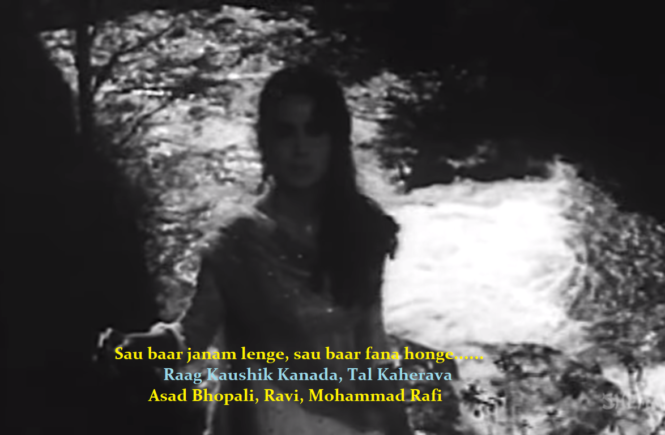Raaga Based Song of the Day: Sau baar janam lenge….
Raag Kaushik Kanada, Tal Kaherava
The ninety-ninth song; one more to go before I reach hundred. The average length of these blogs is about four thousand words – the amount in which average bloggers write about eight to ten posts. Each one of these is a product of hours (if not days) of research and gives you compendium of information that you would cherish.
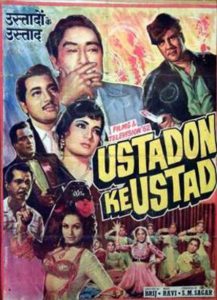
This song is from the 1963 movie Ustadon Ke Ustad directed by Brij and starring Pradeep Kumar and Shakeela. Recently, I gave you a song: Woh jab yaad aaye bahut yaad aaye that was penned by Asad Bhopali for the 1963 movie Parasmani. Well, this song too has been penned by him and composed by Ravi. It was sung by Mohammad Rafi.
Lets look at the story-line to see how the song cane about in the movie:
Pradeep Kumar plays Dinesh, a poor engineer in love with a rich woman Nita (Shakila). He is apprehended by the police after they suspect him of being a bank robber. In the police cell he meets dacoit Mangal Singh (Sheikh Mukhtar). The latter plans an escape so as to sell Dinesh to a violent gang.
After their escape Dinesh tells Mangal that not just police he is in trouble with a vindictive gang of thieves hell bent on killing him for having identified Rita (Helen), the dancer, who was involved in a theft. This makes Mangal think of a plan to sell Dinesh to the gang leader for a bigger sum of money.
Mangal’s plan fails. Saaya (Ashok Kumar) follows Mangal’s people to a hiding place where Dinesh is locked up. After his escape from dacoit Mangal, Dinesh makes another escape attempt from the hideout, this time with attempted suicide near a waterfall. This is where Nita comes searching for him and he feigns being a ghost. This is where this lovely song is sung as a mystery song.
The story takes another twist when Saaya (everyone thought he was a police officer in disguise) betrays Dinesh. Nita is still searching for Dinesh and Mangal assists her by becoming her brother. The story takes some more twists and turns and has a happy ending when the lovers are united and the bad man Saaya (Ashok Kumar) is killed. Rita (Helen) is killed too.
This is the first time I am taking up a song in this raaga.
We have completed ninety-five days of Raaga Based Songs of the Day. Our first post in the series was titled ‘Raaga Based Song Of The Day #1’ and the song was a Mohammad Rafi and Lata Mangeshkar song from the 1970 Shakti Samanta movie Pagla Kahin Ka: Tum mujhe youn bhula na paoge. It is in Raag Jhinjhoti, Tal Kaherava.
Our ninety-eighth post or the last post here was titled ‘Raaga Based Song Of The Day #98‘ and the song was a Yesudas and Hemlata song from the 1976 Basu Chatterjee movie Chitchor starring Amol Palekar, Zarina Wahab and Vijayendra: Tu jo mere sur mein sur mila le. It is also in Raag Pilu Tal Kaherava.
This blog has a number of posts on Raaga based songs in Hindi movies titled similarly; for example: ‘The Best Raaga Based Songs in Hindi Movies – Raaga Jaijaivanti‘.
In the last ninety-eight days of sharing Raaga based songs of the day, I have given you songs based on Raag Jhinjhoti, Gara, Bhimpalasi, Madhuvanti, Shivaranjani, Bihag, Pahadi, Sarang, Pilu, Bhairavi, Khammaj, Charukesi, Kalyan or Yaman, Desh, Malgunji, Kirwani, Kedar, Bageshri, Megh Malhar, Bhupali, Ahir Bhairav, Malkaush, Mand, Adana, Kafi, Rageshri, Jaunpuri, Tilang, Janasammohini, Chayanat, Shuddha Kalyan, Gaur Sarang, Jogiya, Asavari, Maru Bihag, Durga, Lalit, Puria Dhanashri, Bhinna Sahdja, Sohani, Multani, Patdeep, Jaijaiwanti, Tilak Kamod, Hemant, Basant Mukhari, Gujri Todi, Kalavati, Hamir, Bhatiyar, Gawati, Shyam Kalyan, Gorakh Kalyan, Madhamat Sarang, Manj Khammaj, Darbari Kanada, Vibhas, Shankara, Bahar, Nand, Mian Ki Malhar and Jog; making it a total of 62 raagas. The raagas that have been repeated so far are Pahadi, the raaga of my home place in the Himalayas, Maru Bihag, Raag Kirwani, Jhinjhoti, Bhairavi, Gara, Basant Mukhari, Malkauns, Bhairavi, Mand, Sohani, Madhuvanti, Shivaranjani and Adana. Today, I am giving you a new Raag Kaushik Kanada for the first time.
I have already given you the story of the movie and where exactly the song fits into the plot. Let me just add that this plot was found by audiences as of riveting interest and the movie is still remembered as highly watchable. Here is the list of songs in the movie:
| 1 | “Sau Baar Janam Lenge Sau Baar Fanah” | Mohammed Rafi |
| 2 | “Milte Hi Nazar Tumse Ham Ho Gaye Diwane” | Asha Bhosle, Mohammed Rafi and Manna Dey |
| 3 | “Hasino Se To Bas Sahab Salamat Dur Ki Achhi” | Mohammed Rafi |
| 4 | “Mainne Kahaa Thaa Aanaa Sunday Ko, Sunday Ko” | Asha Bhosle, Mohammed Rafi |
| 5 | “Raat Chup Hai Chandni Madhosh Hai Muskura Bhi Do” | Asha Bhosle, Ravi |
| 6 | “Mere Dil Ko Jiski Talash Thi Maine Vo Sitamghar Pa Liya” | Asha Bhosle, Mohammed Rafi |
 All these songs were penned by Asad Bhopali. He was born as Asadullah Khan on 10 Jul 1921 in Bhopal.
All these songs were penned by Asad Bhopali. He was born as Asadullah Khan on 10 Jul 1921 in Bhopal.
Asad Bhopali wrote two songs for Fazli Brothers’ Duniya (1949): Rona hai to chupke chupke (sung by Mohammad Rafi) and Armaan lute, dil toot gaya (sung by Suraiyya). The next year, he wrote songs for a couple of films; these songs were sung by Lata Mangeshkar and Shamshad Begum. Bhopali’s big break was BR Chopra’s Afsana (1951), for which he wrote 5 songs.
One of his early songs that really made him famous was ‘Woh jab yaad aaye bahut yaad aaye’ for the 1963 movie Parasmani (the debut movie of Laxmikant Pyarelal) (Please see: ‘Songs That Tug At Your Emotions #36‘).
He received his only Filmfare Award for Best Lyricist very late for the 1989 movie Maine Pyar Kiya’s song: Dil deewana bin sajna ke maane na.
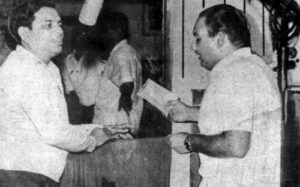
I am fond of Music Director Ravi Shankar Sharma or simply Ravi, not just because he is my namesake. First of all, he was the discovery of my favourite Hemant Kumar. Together with Kalyanji, he was assistant to Hemant da in the 1954 movie Naagin. The film included thirteen tracks, including the hit ‘Man Dole Mera Tan Dole’, whose ‘Been Music’ was performed by Kalyanji on clavioline and by Ravi on harmonium. I am also fond of Ravi for having got two of the three Filmfare Awards for Best Lyricist: Chaudhvin ka chand ho and Husn waale tera jawaab nahin. The instrument Sitar figured in many of Ravi’s songs, just like the one that I have selected for you tonight. Ravi was known for bringing poignancy of some of his songs to the fore through his excellent compositions. The song that comes to mind is Shakeel Badayuni’s Do Badan song picturised on Asha Parekh and sung by Lata Mangeshkar: Lo aa gayi unaki yaad woh nahin aaye.
Asad Bhopali and Ravi came together for the 1962 Nisar Ahmad Ansari movie Tower House starring Ajit and Shakila. The movie had very good songs:
- Ai mere dil-e-nadaan tu gham se na ghabrana.
- Main khushnaseeb hoon mujhako kisi ka pyar mila.
- Aaj ki raat andhera bhi hai tanhai bhi.
- Mausam hai jawan noor mein dube hain nazaare.
- Ye sitam kya hai hamako bana kar deewana chale.
- Zara bach ke shikari shikar karna.
And then there was this movie whose songs list I have already given you.
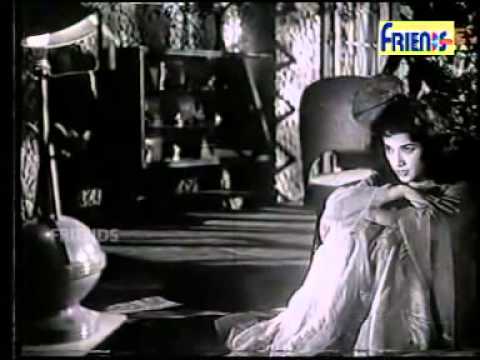
Surprisingly, for someone who learnt music mostly by himself Ravi was well rooted in raagas. His favourite raaga appears to be Bhopali or Bhupali. In the 1963 BR Chopra movie Ravi had two out of the seven songs composed in this raaga: Ye hawa ye fiza, and Tujhako mera pyar pukaare. One of the best songs in Raag Kedar: Darshan do Ghanshyam has also been composed by Ravi. Nobody can ever forget his Chaudhvinh ka chand ho in Raag Pahadi and Ye raatein ye mausam nadi ka kinara in Raag Kirwani.
This song, as I told you, is in Raag Kaushik Kanada, Tal Kaherava.
Raag Kaushik/Kaushi/Kausi Kanada belongs to the Asawari thaat. Its Jati is Shadhav – Sampurna Vakra, which means it is hexatatonic (six notes or swar) in Aaroha (ascending) with Re (Rishab) and Pa (Pancham) varjay. All seven swar (heptatonic) in Avroha (descending). Gandhar, Dhaivat and Nishad are Komal. Rest all swar are Shuddha. The raaga is well suited for the third prahar of the night (Midnight to 3 AM).
Other than this song there are no notable songs in Hindi movies composed in Kaushik or simply Kaushi/Kausi Kanada.
I have, at various places earlier, told you about the Kaherava Tal and hence don’t feel the need to repeat it here.
Before we actually take up the song, first, lets take up the value added learning of today. From the last sixteen times we started learning about some of the leading personalities in Indian Classical Music or Shastriya Sangeet. The first one that we took up was Ustaad Asad Ali Khan, the finest Rudra Veena player in the country. Then we took up Pandit Hari Parsad Chaurasia, the greatest Bansuri player in the country. Then we talked about Ali Akbar Khan, the greatest Sarod player in the country. Then we took up Pandit Ravi Shankar, the greatest Sitar player in the world. Then we took up the greatest classical singer in the country (of Carnatic tradition): MS Subbulakshmi. Then, we took up the greatest classical singer in the country (of Hindustani tradition): Pandit Bhimsen Joshi. Then, we learnt about the Shehnai maestro Ustad Bismillah Khan. Then, we learnt about Annapurna Devi, a great Surbahar (bass sitar) player of Hindustani Classical Music. Thereafter, we took up Pandit Shiv Kumar Sharma, the grestest Santoor player in the country. Then we learnt a little more about Ustaad Alla Rakha Qureshi or simply Alla Rakha, the Tabla Maestro and father of Ustaad Zakir Hussain. Then we learnt about the master and one of the pioneers of fusion: Anand Shankar. Then we learnt about a Veena player who was also a great filmmaker: Sundaram Balachander. Then we learnt about Sarod Player Ustad Amjad Ali Khan. And then we learnt about Ustaad Zakir Hussain, the Tabla maestro. Then we learnt about Sitar Player and Composer Anoushka Shankar. And then we covered vocalist Pandit Jasraj in the last post. We then covered violinist L Subramaniam. And finally we learnt about Sitarist: Ustaad Vilayat Khan.
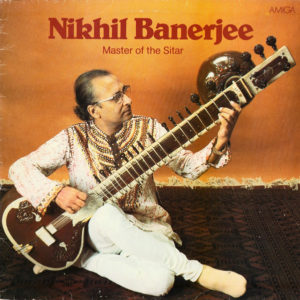
Tonight, we shall take up another great sitarist: Nikhil Banerjee. He was born on 14 Oct 1931 in Calcutta. His father, Jitendranath Banerjee, was an amateur sitarist and Banerjee was fascinated by his father’s playing. Initially, his father didn’t encourage Nikhil becoming a sitarist but relented when he was five. The initial training of the young child was at the hands of his father. He became a child prodigy. He won an all-India sitar competition and became the youngest musician employed by All India Radio at the age of nine. Around 1946 Nikhil Banerjee met the great khyal singer Amir Khan through the master’s teaching of Nikhil Banerjee’s sister, and his enthusiasm for his music was reinforced by hearing him in concert a couple of years later.
In 1947 Banerjee met Ustad Allauddin Khan, who was to become his main guru along with his son, Ali Akbar Khan. Both were sarod players. Banerjee went to Allauddin Khan’s concerts and was desperate to have him as his teacher. Allauddin Khan did not want to take on more students, but changed his mind after listening to one of Banerjee’s radio broadcasts. Allauddin Khan was Banerjee’s main teacher, after he left Maihar he also learned from Ali Akbar Khan, the son of Allaudin Khan, for many years.
Ustad Allauddin Khan passed on to Nikhil not only playing technique but the musical knowledge and approach of the Maihar gharana. After Maihar, Banerjee embarked on a concert career that was to take him to all corners of the world and last right up to his untimely death on 27 Jan 1986. All through his life he kept taking lessons from Ustad Allauddin Khan and his children, Ustad Ali Akbar Khan and Smt. Annapurna Devi. Perhaps reflecting his early upbringing, he always remained a humble musician, and was content with much less limelight than a player of his stature could have vied for. Even so, in 1968, he was decorated with the Padma Shri, and in 1974 received the prestigious Sangeet Natak Akademi Award.
Today, he is commonly regarded as one of the greatest sitarists of the 20th century and is often spoken of as being on a level with the other two masters Ravi Shankar and Vilayat Khan.
Returning to the song now. The song, as I told you, is from the 1963 Brij movie Ustadon Ke Ustad. It is a soft melody in Raag Kaushik or Kaushi/Kausi Kanada that lends to the song a certain enigma that goes well with the vapour that rises from the water-fall. In that respect the song is in line with – though with better lyrics and picturisation – than such songs as Gumnaam hai koi.
Ladies and gentlemen, please enjoy in Raag Kaushik Kanada Tal Kaherava, Moahammad Rafi sing a composition of Ravi on the lyrics of Asad Bhopali in the 1963 Brij movie Ustadon Ke Ustad starring Pradeep Kumar, Shakila, Ashok Kumar and Sheikh Mukhtar: Sau baar janam lenge, sau baar fana honge…..
सौ बार जनम लेंगे, सौ बार फ़ना होंगे
ऐ जान-ए-वफ़ा फिर भी, हम तुम न जुदा होंगे
क़िस्मत हमे मिलने से, रोकेगी भला कब तक
इन प्यार की राहों में, भटकेगी वफ़ा कब तक
क़दमों के निशाँ खुद ही, मंज़िल का पता होंगे
ये कैसी उदासी है, जो हुस्न पे छाई है
हम दूर नहीं तुम से, कहने को जुदाई है
अरमान भरे दो दिल, फिर एक जगह होंगे
https://www.youtube.com/watch?v=CTprvBjARLY
We have intended to learn about Raaga based music whilst we entertain ourselves with Raaga based songs. So, lets, once again, take stock of our collective learning so far:
- On the first day we learnt about the Raaga system devised by Pandit Vishnu Narayan Bhatkhande, which is the prevalent system in Hindustani Classical Music and based on ten Thaats.
- On the second day we learnt about Tal or Taal.
- On the third day we learnt about characteristics of Raagas that included Swar, Jati, Thaat, Arohana and Avarohana, Vadi, Samvadi and Pakad.
- On the fourth day, we learnt about Sargam.
- On the fifth day, we learnt about notations used in Indian classical music or simply Swar Lipi.
- On the sixth day, we learnt about the Ras (sentiments) that Raagas evoke.
- On the seventh day, we learnt about various types of Swar: Shuddha, Achal, Vikrut, Komal and Teevra.
- On the eighth day, we learnt the parts of a composition in Indian Classical Music.
- On the ninth day, we learnt the names of some of the popular instruments used in Indian Classical Music.
- On the tenth day, we learnt about the sources of names of Raagas.
- On the eleventh day, we learnt about why Bhairavi is the first raag to be taught to beginners and also why it is the last in a performance.
- On the twelfth day, we learnt about Khammaj Thaat.
- On the thirteenth day, we learnt about Tal Punjabi Theka or Sitarkhani.
- On the fourteenth day, we learnt about Alap.
- On the fifteenth day, we learnt about List of Raagas (Raagmala) in my favourite book: Sri Guru Granth Sahib.
- On the sixteenth day, we learnt about tips for raaga identification.
- On the seventeenth day, we learnt the basics of Gharana system.
- On the eighteenth day, we learnt about Filmi Sangeet.
- On the nineteenth day, we learnt about the commonest Tal in Raagas: Tintal.
- On the twentieth day, we learnt about the Kafi Thaat.
- On the twenty-first day, we learnt a little more in detail about the classification of Raagas.
- On the twenty-second day, we learnt the essential differences between Bhairavi and Bhairav.
- On the twenty-third day, we learnt a little more in detail about the Jati or Jaati of a raaga.
- On the twenty-fourth day, we learnt details of Thaat Bilawal, the most basic thaat in the Bhatkhande’s system of raagas.
- On the twenty-fifth day, we learnt about Tintal.
- On the twenty-sixth day, we learnt in detail about the Raaga – Samay linkage.
- On the twenty-seventh day, we learnt about Lehar.
- On the twenty-eighth day, we learnt about the history of the Hindustani Music.
- On the twenty-ninth day, we learnt about Dhrupad.
- On the thirtieth day, we learnt about Rupaktal that I was introduced to, a few months back, by my friend Anand Desai.
- On the thirty-first day, we learnt about Khayal.
- On the thirty-second day, we learnt about Thumri.
- On the thirty-third day, we learnt about Tappa.
- On the thirty-fourth day, we learnt about Tarana.
- On the thirty-fifth day, we learnt about Tal Dipchandi (Moghali).
- On the thirty-sixth day, we learnt about Tabla.
- On the thirty-seventh day, we learnt about Kirtan.
- On the thirty-eighth day, we learnt about Pakhawaj.
- On the thirty-ninth day, we learnt about Hori.
- On the fortieth day, we learnt about Dadra.
- On the forty-first day, we learnt about Kajri.
- On the forty-second day, we learnt about Chaiti.
- On the forty-third day, we learnt about Sarangi.
- On the forty-fourth day, we learnt about Shehnai.
- On the forty-fifth day, we learnt about Sarod.
- On the forty-sixth day, we learnt about Bansuri.
- On the forty-seventh day, we learnt about Ektal and Tanpura.
- On the forty-eighth day, we learnt about Veena.
- On the forty-ninth day, we repeated our learning of Veena with a small excitement added.
- On the fiftieth day, we learnt about Dilruba/Esraj.
- On the fifty-first day, we learnt about Jaltarang.
- On the fifty-second day we learnt about Qawwali.
- On the fifty-third day, we learnt about Sitar.
- On the fifty-fourth day, we learnt about Surbahar.
- On the fifty-fifth day, we learnt about Harmonium.
- On the fifty-sixth day, we learnt about Santoor.
- On the fifty-seventh day, we learnt about Swarmandal.
- On the fifty-eighth day, we learnt about the Shruti Box.
- On the fifty-ninth day, we learnt about Alankar.
- On the sixtieth day, we learnt about singing in Aakaar.
- On the sixty-first day, we learnt about the Classification of Indian Musical Instruments.
- On the sixty-second day, we learnt a little about Carnatic Music.
- On the sixty-third day, we learnt about Natya Shastra.
- On the sixty-fourth day, we learnt about evolution of musical instruments in India down the ages.
- On the sixty-fifth day, we learnt about Riyaaz.
- On the sixty-sixth day, we looked at a list of Raagas in Hindustani Classical Music.
- On the sixty-seventh day, we learnt about the health benefits of raagas.
- On the sixty-eighth day, we learnt a little more comprehensively about the moods and emotions that raagas evoke.
- On the sixty-ninth day, we learnt about a mobile application to help identify raagas.
- On the seventieth day, we learnt about Melakarta Raagas.
- On the seventy-first day, we learnt about Sangita Makarand.
- On the seventy-second day, we learnt about TaalMala an Android application for personalized accompaniment of musical instruments during Riyaaz or even during Concert.
- On the seventy-third day, we learnt about Indian Classical Ragas, an Android application for mobile phones.
- On the seventy-fourth day, we learnt about Saregama Classical, another application for Classical Raagas.
- On the seventy-fifth day, we learnt about a free online service available to learn Indian Classical Music.
- On the seventy-sixth day, we learnt about List of Hindustani Classical Musical Festivals in India and Abroad.
- On the seventy-seventh day, we learnt about List of Carnatic Musical Festivals in India and Abroad.
- On the seventy-eighth day, we learnt about Jhaptal.
- On the seventy-ninth day, we learnt about Ektal.
- On the eightieth day, we learnt about Tivra Tal.
- On the eighty-first day, we learnt about the greatest Rudra Veena player ever: Ustaad Asad Ali Khan.
- On the eighty-second day, we learnt about the greatest Bansuri player alive: Pandit Hariprasad Chaurasia.
- On the eighty-third day, we learnt about the best Sarod player in the country: Ustaad Ali Akbar Khan.
- On the eighty-fourth day, we learnt about the greatest Sitar player in the world: Pandit Ravi Shankar.
- On the eighty-fifth day, we learnt about the greatest Indian vocalist of Carnatic tradition: MS Subbulakshmi.
- On the eighty-sixth day, we not just learnt about the greatest vocalist of Hindustani tradition: Pandit Bhimsen Joshi but also learnt about Tal Hinch.
- On the eighty-seventh day, we learnt about the Shehnai maestro Ustaad Bismillah Khan.
- On the eighty-eighth day, we learnt about Annapurna Devi, the greatest Surbahar player in India.
- On the eighty-ninth day, we learnt about Pandit Shiv Kumar Sharma, the greatest Santoor Player in the country.
- On the ninetieth day, we learnt about Ustaad Alla Rakha, the Tabla maestro.
- On the ninety-first day, we learnt about Anand Shankar, the great fusion musician from Bengal.
- On the ninety-second day, we learnt about Sundaram Balachander, the great Veena player and film-maker.
- On the ninety-third day, we learnt about Ustaad Amjad Ali Khan, the great Sarod player.
- On the ninety-fourth day, we learnt about the Tabla maestro: Ustaad Zakir Hussain.
- On the ninety-fifth day, we learnt about the Sitar player and Composer: Anoushka Shankar.
- On the ninety-sixth day, we learnt about the Vocalist Pandit Jasraj.
- On the ninety-seventh day, we learnt about the great violinist L Subramaniam.
- On the ninety-eighth day, we learnt about one of the greatest sitarists: Ustaad Vilayat Khan.
- And today, on the ninety-ninth day, we learnt about another great sitarist: Nikhil Banerjee.
There is much more still to be learnt and enjoyed.
Please stay tuned!
